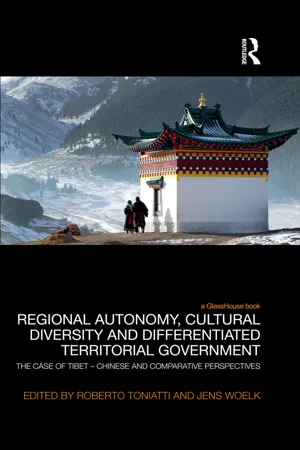
Regional Autonomy, Cultural Diversity and Differentiated Territorial Government
The Case of Tibet – Chinese and Comparative Perspectives
- 322 pages
- English
- ePUB (mobile friendly)
- Available on iOS & Android
Regional Autonomy, Cultural Diversity and Differentiated Territorial Government
The Case of Tibet – Chinese and Comparative Perspectives
About this book
Regional Autonomy, Cultural Diversity and Differentiated Territorial Government assesses the current state of the international theory and practice of autonomy in order to pursue the possibility of regional self-government in Tibet. Initiated by a workshop and roundtable with political representatives from different autonomous regions, including His Holiness the 14th Dalai Lama, this book brings together a group of distinguished international scholars to offer a much-needed enquiry into solutions to the Tibetan quest for 'genuine' autonomy. Examining the Chinese framework of regional self-government, along with key international cases of autonomy in Europe, North America and Asia, the contributors to this volume offer a comprehensive context for the consideration of both Tibetan demands and Chinese worries. Their insights will be invaluable to academics, practitioners, diplomats, civil servants, government representatives, international organisations and NGOs interested in the theory and practice of autonomy, as well as those concerned with the future of Tibet.
Frequently asked questions
- Essential is ideal for learners and professionals who enjoy exploring a wide range of subjects. Access the Essential Library with 800,000+ trusted titles and best-sellers across business, personal growth, and the humanities. Includes unlimited reading time and Standard Read Aloud voice.
- Complete: Perfect for advanced learners and researchers needing full, unrestricted access. Unlock 1.4M+ books across hundreds of subjects, including academic and specialized titles. The Complete Plan also includes advanced features like Premium Read Aloud and Research Assistant.
Please note we cannot support devices running on iOS 13 and Android 7 or earlier. Learn more about using the app.
Information
Part I
Differentiated territorial government in China: Potential for Tibet?
Chapter 1
Foreign influence and constitutionalism in the PRC
1. Introductory observations
1.1 Aims and limitations
1.2 Other definitional considerations
2. China’s receptiveness to foreign influence
2.1 Dynastic China’s rejection of challengers4
2.1.1 Military and political challenges
- the Xiongnu tribal attacks, beginning in the second century BCE and launched from their nomadic ranges in the steppes to the north and northwest of China in an effort to gain access to food sources, especially in winter;
- the Tubo Turks’ attacks in the early fourth century CE, resulting in the capture of the city of Loyang and then of the emperor himself;
- the Tibetans’ incursions in both the north and the south later in the fourth century CE; and
- the takeover of the northern part of China in the twelfth century CE by the Jin people, forcing the Song dynastic leaders south (thereby starting the so-called ‘Southern Song’ Dynasty).
2.1.2 Religious and intellectual challenges
Table of contents
- Cover
- Title
- Copyright
- Contents
- Notes on contributors
- Acknowledgements
- Introduction: Neither Panacea, nor Pandora’s Box: Comparing autonomy with a view on Tibet and China
- PART I Differentiated territorial government in China: Potential for Tibet?
- PART II Practice of regional autonomy: Experiences compared
- Concluding observations: One country, three systems: The Tibetan quest for genuine autonomy between European experiences and Asian perspectives
- Appendix: The 17-Point Agreement
- Index